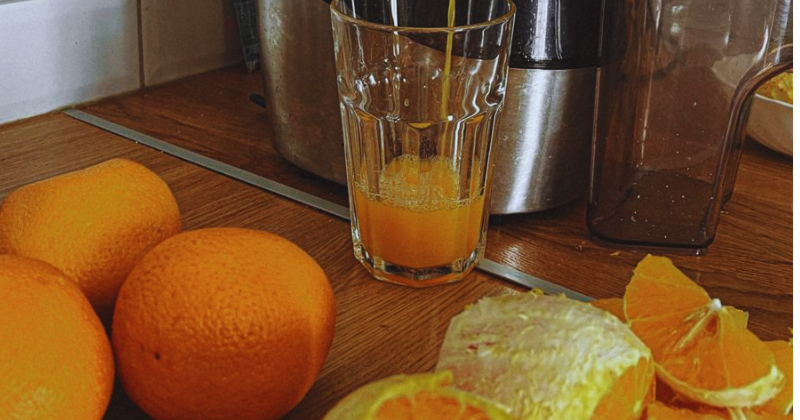Prep Time: 10 minutes | Active Time: 5 minutes | Total Time: 15 minutes | Serves: 2-3 glasses | Difficulty: Easy
Table of Contents
Every Sunday morning when I was growing up, my grandmother would hand-squeeze fresh orange juice for the entire family, her weathered hands working magic with a simple wooden reamer and pure determination. The kitchen would fill with the bright, citrusy aroma that meant weekend mornings and family togetherness. That homemade orange juice was nothing like the store-bought versions – it was vibrant, naturally sweet, and bursting with life. Now, decades later, I’ve perfected the art of making fresh orange juice at home, and I’m here to share every secret I’ve learned along the way. This isn’t just about squeezing oranges; it’s about creating liquid sunshine that transforms ordinary mornings into something special. Whether you’re looking to start your day with maximum nutrition, impress weekend guests, or simply want to taste what orange juice is supposed to taste like, this comprehensive guide will teach you everything you need to know about making the most delicious, vitamin-packed fresh orange juice right in your own kitchen.
Why You’ll Love Making Fresh Orange Juice
Creating homemade orange juice isn’t just a cooking project – it’s your gateway to experiencing citrus the way nature intended. First and foremost, the nutritional benefits are incomparable to store-bought alternatives; fresh-squeezed orange juice contains higher levels of vitamin C, folate, and antioxidants because there’s no processing or long storage periods that degrade these vital nutrients. The flavor difference will absolutely amaze you – fresh orange juice has a bright, complex taste profile with natural variations in sweetness and acidity that you simply cannot get from pasteurized, processed juices. It’s incredibly easy to make with minimal equipment, requiring nothing more than fresh oranges and either your hands or a simple juicing tool, making it accessible to anyone regardless of kitchen experience. This homemade approach is also surprisingly cost-effective when oranges are in season, often producing higher quality juice for less money than premium store brands. Perhaps most importantly, making fresh orange juice is completely family-friendly and can become a wonderful weekend tradition that gets everyone involved in the kitchen, teaching children about whole foods while creating lasting memories around healthy eating habits.
Ingredient Insights & Selection
The secret to exceptional fresh orange juice lies entirely in selecting the right oranges and understanding how different varieties impact your final product. Navel oranges are excellent all-around choices, offering sweet flavor with minimal seeds and easy-to-remove peels, making them perfect for beginners or those prioritizing convenience. Valencia oranges are considered the gold standard for juicing because of their high juice content and perfect balance of sweet and tart flavors, though they contain more seeds that require straining. Blood oranges create stunning ruby-colored juice with a complex, slightly berry-like flavor that’s perfect for special occasions or when you want something visually dramatic. When selecting oranges, look for fruits that feel heavy for their size – this indicates high juice content – and have smooth, firm skin without soft spots or wrinkled areas. The best oranges will have a slight give when gently pressed but should never feel mushy. Seasonality plays a crucial role in quality and price; peak orange season runs from December through April, with different varieties ripening at different times throughout this period. For optimal storage, keep oranges at room temperature if using within a week, or refrigerate them for up to two weeks. Before juicing, bring refrigerated oranges to room temperature for about 30 minutes, as warm oranges yield significantly more juice than cold ones.
Key Techniques & Method Overview
Mastering fresh orange juice requires understanding four fundamental techniques that separate amateur attempts from professional-quality results. The preparation technique is your foundation – rolling oranges firmly on a hard surface while applying pressure breaks down internal membranes and can increase juice yield by up to 30 percent, while microwaving oranges for 10-15 seconds warms them internally and makes them even more cooperative. Temperature management is crucial throughout the process; room temperature oranges not only yield more juice but also release more aromatic compounds that contribute to flavor complexity, so always plan ahead and remove refrigerated oranges early. The extraction method you choose dramatically impacts both yield and texture – hand-squeezing provides the purest juice but requires significant effort, manual juicers offer good control with less work, while electric juicers maximize efficiency but may incorporate more pulp and bitter oils from the peel. Straining technique is where you control the final texture and quality of your juice; a fine-mesh strainer removes seeds and large pulp pieces while preserving beneficial fiber, while a double-strain through cheesecloth creates silky-smooth juice that rivals commercial products. Understanding these techniques allows you to customize your orange juice exactly to your preferences, whether you prefer pulpy, rustic juice that celebrates the whole fruit or elegant, refined juice that showcases pure citrus essence.

Step-by-Step Instructions
- Prepare your oranges for maximum yield by selecting 4-6 medium oranges (about 2 pounds) and bringing them to room temperature if refrigerated. Roll each orange firmly against your countertop while applying pressure for 10-15 seconds, which breaks down internal membranes and significantly increases juice extraction.
- Warm the oranges slightly by microwaving them for 10-15 seconds, which further softens the internal structure and makes juicing easier. Be careful not to overheat, as this can create hot spots that might burst when squeezed.
- Cut oranges strategically by slicing each orange in half crosswise (perpendicular to the stem) rather than lengthwise, exposing the maximum number of juice sacs and creating the optimal shape for squeezing or using a reamer.
- Extract the juice using your preferred method: For hand-squeezing, hold each half cut-side up and squeeze firmly while twisting slightly, working over a bowl to catch every drop. For reamer or manual juicer use, insert the tool into the center and twist while applying downward pressure, allowing the juice to flow naturally.
- Strain for optimal texture by pouring the fresh juice through a fine-mesh strainer to remove seeds and large pulp pieces. For ultra-smooth juice, strain a second time through cheesecloth or a coffee filter, though this will remove beneficial fiber.
- Taste and adjust your fresh orange juice by adding a pinch of salt to enhance natural sweetness, or a small amount of honey if your oranges are particularly tart. Remember that fresh juice should taste bright and vibrant, not flat or overly sweet.
- Serve immediately for the best flavor and nutritional value, as fresh orange juice begins losing vitamin C and developing off-flavors within hours of extraction. Pour over ice if desired, and garnish with orange wheel for visual appeal.
Pro Tips & Troubleshooting
The difference between good fresh orange juice and absolutely spectacular results lies in these professional secrets that commercial producers don’t want you to know. Always juice oranges at room temperature or slightly warm – cold oranges can yield 40% less juice than properly warmed ones, so plan ahead and never juice straight from the refrigerator. If your oranges seem dry or difficult to juice, they may be past their prime; look for oranges with thin, smooth skin rather than thick, puffy peels that indicate older fruit with less juice content. When hand-squeezing produces disappointing results, try the fork technique: insert a fork into the center of each orange half and twist while squeezing to break up stubborn pulp and release more juice. For consistently smooth results without losing beneficial pulp, use the double-bowl method: strain once through a coarse strainer to remove seeds, then strain again through a fine mesh to achieve your desired consistency. If your fresh orange juice tastes bitter, you may be pressing too hard and extracting oils from the white pith; use gentler pressure and avoid squeezing the peels themselves. Store any leftover juice in the refrigerator in a glass container with minimal air space, and consume within 24 hours for optimal flavor and nutrition – fresh juice deteriorates rapidly compared to processed alternatives.
Variations & Customizations
Transform your basic fresh orange juice into personalized creations that suit every taste preference and dietary need. Create a tropical blend by mixing equal parts orange juice with fresh pineapple juice and a splash of coconut water for an exotic morning treat. For a sophisticated flavor profile, add freshly squeezed lemon or lime juice (about 1 tablespoon per cup) to brighten the taste and add complexity. Make it a wellness drink by incorporating fresh ginger (grated and strained) or turmeric for anti-inflammatory benefits. For those watching sugar intake, dilute the juice with sparkling water to create a refreshing, lower-calorie citrus spritzer. Seasonal variations work beautifully – blend in cranberry juice during winter holidays, or add fresh mint and cucumber for summer refreshment. Scale the recipe easily by calculating roughly 3-4 medium oranges per 8-ounce serving, making it simple to prepare juice for large family gatherings or meal prep for the week ahead.
Storage, Reheating & Make-Ahead Tips
Proper storage is crucial for maintaining the vibrant flavor and nutritional value of your homemade orange juice. Fresh-squeezed juice should be consumed immediately for peak flavor and vitamin content, but can be refrigerated in an airtight glass container for up to 24-48 hours maximum. Never store fresh orange juice in metal containers, as the acidity can react with metal and create off-flavors. For longer storage, freeze fresh juice in ice cube trays, then transfer frozen cubes to freezer bags for up to three months – these work perfectly for smoothies or can be thawed for drinking, though the texture will be slightly different. Make-ahead preparation works best by pre-rolling and warming oranges the night before, storing them covered at room temperature, then juicing fresh in the morning. Unlike processed juices, fresh orange juice doesn’t reheat well and should always be served cold or at room temperature. To refresh day-old juice, add a splash of fresh lemon juice to brighten the flavor and restore some of that just-squeezed taste.
Serving Suggestions & Pairings
Fresh orange juice shines in countless serving situations, from elegant brunch spreads to casual weekday breakfast routines. Serve it in chilled glasses alongside classic breakfast foods like pancakes, waffles, or French toast, where its natural acidity cuts through rich, syrupy flavors beautifully. For sophisticated entertaining, create mimosas by mixing equal parts fresh orange juice with champagne, or craft non-alcoholic spritzers with sparkling water and fresh herb garnishes like mint or rosemary. The juice pairs wonderfully with eggs Benedict, smoked salmon, or fresh fruit salads, providing a bright contrast to rich or delicate flavors. Use it as a base for smoothies combined with yogurt and berries, or incorporate it into marinades for chicken or pork where the natural enzymes help tenderize proteins. For a complete wellness experience, serve fresh orange juice alongside avocado toast and Greek yogurt for a breakfast that provides sustained energy and balanced nutrition throughout the morning.
Making fresh orange juice at home is one of those simple pleasures that connects us to real food and creates moments of pure satisfaction in our daily routines. The process itself becomes a mindful practice that slows down our rushed mornings and reminds us that the best things in life often come from the simplest ingredients treated with care and attention. Once you experience the incredible difference in taste, nutrition, and satisfaction that comes from fresh-squeezed orange juice, you’ll wonder why you ever settled for anything less. Start your fresh orange juice journey today, and discover how this liquid sunshine can transform your mornings into something truly special!

